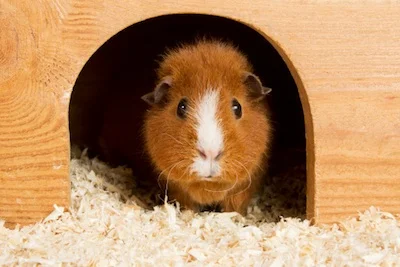A guinea pig is a small animal.
They are good pets.
Their front teeth are always growing.
They chew hard food to stop their teeth getting too long.
There are different colours of guinea pig.
What is a guinea pig?
Guinea pigs, also known as cavies or domestic cavies, are mammals. They are rodents, a large group of animals whose front teeth grow continuously and are kept to reasonable size by gnawing on hard things. Guinea pigs are part of the cavy family.
Guinea pigs are native to Guyana in South America. They are not related to pigs, nor do they come from Guinea! Perhaps they are named in a mispronunciation of 'Guyana'. They are related to rats and mice.
Guinea pigs are different colours ©Getty Images
Guinea pigs were domesticated (tamed) by ancient South American peoples known as the Incas over 3000 years ago. They were pets as well as a source of food. Spanish explorers in the 16th Century took guinea pigs with them when they returned to Europe, where they became very popular pets. So popular have they been for so many centuries that they no longer exist in the wild, although some of their relatives, now also called Guinea pigs live in the forests and grasslands of South America. They are social animals that live in groups. They are most active at dawn and dusk.
Body
Guinea pigs are small animals weighing about 700-900 grams. They are herbivores, meaning they are plant eaters. They have small ears and their eyes are on either side of their heads. They have about 20 teeth, which grow continuously.
Mother with young ©Getty images
Life Cycle
Females are called sows, and males are called boars. About 70 days after a boar and sow mate, babies will be born. There are usually six to ten babies in a litter.
The young are born with hair and teeth, and with their eyes open. Even though they suckle milk from their mother's body, baby guinea pigs are able to eat solid food from birth.
Pet guinea pigs
Guinea pigs should be fed vegetables ©Getty Images
Guinea pigs are delightful pets. They are very tame and friendly, and like being handled gently. In the wild they live in groups, so it is a good idea to have at least two because of their social behaviour.
Housing pet guinea pigs
A hutch for your guinea pigs should be large enough for the animals to move freely about inside. It should be well ventilated and have a solid bottom. A cardboard or wooden box with an open bottom and a hole cut in the side should be placed inside the cage as a separate sheltered place where the animals can sleep, or if frightened, hide. The hutch should be in a sheltered spot.
Guinea pig peeping out of its bedroom ©Getty Images
Bedding can be a layer of newspaper with hay on top but it must be changed often. Cat litter can be used in the cage near where the guinea pigs eat because this is where they will pee and poo.
Feeding your pet guinea pigs
Guinea pig pellet food can be bought from the pet shop. Because their front teeth grow continuously, gnawing food such as dry pellets helps keep their teeth to a good size.
Guinea pigs should also be fed hay, fresh fruits such as apples, pears, peaches, strawberries and fresh vegetables every day, such as broccoli, carrots and cauliflower. Guinea pigs need fresh water too, even though most of the moisture they need will come from their food.
Care of guinea pig pets
Guinea pigs need plenty of exercise and should have a safe playpen area. It can be joined onto the cage or the guinea pigs can be taken to it each day. The cage and the play areas should be cleaned thoroughly at least once a week.
Long-haired guinea pigs must be brushed ©Getty Images
Responsible pet ownership
Pet guinea pigs depend on their owners for food, protection and shelter. Before becoming a pet owner, think carefully about all the things you will have to do to care for your pet responsibly.






